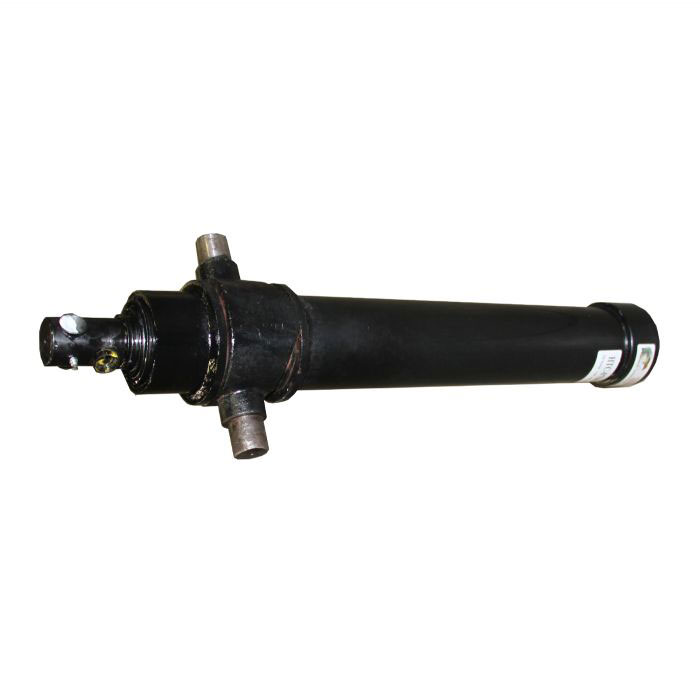Analysis and Suggestions of Oil
Cylinder Leakage
1. Leakage of hydraulic cylinder
(1) Oil leakage between the surface of the piston rod and the relative movement of the guide sleeve. If the hydraulic cylinder reciprocates under the condition of no oil leakage, the surface of the piston rod and the seal will be in a state of dry friction, which will increase the wear of the seal and greatly shorten its service life. Therefore, a certain degree of oil leakage between the surface of the piston rod and the seal is allowed to play the role of lubrication and friction reduction, but it is required that the piston rod does not leak oil when it is stationary. Every time the piston rod moves 100mm, the amount of oil leakage must not exceed two drops, otherwise it will be regarded as serious leakage. The leakage of the seal along the piston rod and the guide sleeve is mainly caused by the damage of the sealing ring installed on the guide sleeve, the strain on the piston rod, the grooves, and the pits.
(2) Oil leakage along the outer seal between the cylinder barrel and the guide sleeve. The seal between the cylinder barrel and the guide sleeve is a static seal. The possible reasons for oil leakage are: poor quality of the sealing ring; insufficient compression of the sealing ring; scratched or damaged sealing ring; quality of the cylinder and the surface processing of the sealing groove of the guide sleeve Rough.
(3) Oil leakage caused by defects in the hydraulic cylinder body and its mating parts. If the hydraulic cylinder body has defects in its cooperation, it will gradually expand under the action of the pressure pulsation or shock vibration of the hydraulic system and cause oil leakage.
(4) Oil leakage between the cylinder body and the fixed mating surface of the end. When the O-ring seal on the mating surface fails or has insufficient compression, aging, damage, unqualified accuracy, poor processing quality, irregular products, or repeated use, oil leakage will occur. Just choose the right O-ring to solve the problem.
2. Leakage in hydraulic cylinder
There are two oil leaks inside the hydraulic cylinder. One is the static seal between the piston and the piston rod. As long as you choose a suitable O-ring, you can prevent oil leakage; the other is the dynamic seal between the piston and the cylinder wall. . Causes of internal leakage in hydraulic cylinders;
(1) It is suitable for the bending of the plug rod or the poor coaxiality of the piston rod. When the coaxiality between the piston and the cylinder barrel is too poor, the gap between the outer edge of the piston and the cylinder barrel sound is reduced, causing the inner diameter of the cylinder to produce partial wear and oil leakage. In severe cases, it will cause the cylinder to pull and increase the internal leakage.
(2) Damage or failure of the secret pass. When the material or structure type of the seal is inconsistent with the conditions of use, it will cause internal leakage. Seal failure, insufficient compression, aging, damage, unqualified geometric accuracy, poor processing quality, non-standard products, seal hardness, pressure rating, deformation rate and strength range and other indicators are unqualified; if the seal is improperly installed, Surface wear or hardening, as well as the expiration of life but not timely replacement, etc., will cause internal leakage;
(3) Iron housing and hard foreign objects enter the hydraulic cylinder. There is generally a gap of 0.5mm between the outer circle of the piston and the cylinder.
(4) There are problems with the design, processing and installation of the sealing ring. If the design of the seal ring does not meet
According to specifications, the size of the sealing groove is unreasonable, the accuracy of the seal fit is low, and the fit gap is too poor, which will cause damage to the seal and cause internal leakage; when the surface roughness and flatness of the seal are too poor or the processing quality is also poor, It will cause the seal to operate and cause internal leakage; if the assembly is not carefully, the sand and dust on the joint surface or the large plastic deformation due to the operation will also cause internal leakage.
(5) The piston radius or roundness of the hydraulic cylinder is out of tolerance, the piston has burrs or depressions, and the chrome plating falls off, which will cause internal leakage.

